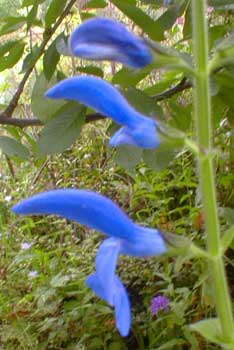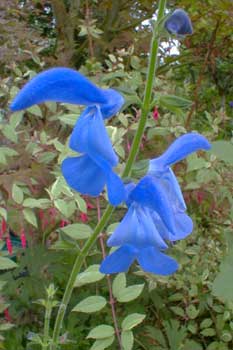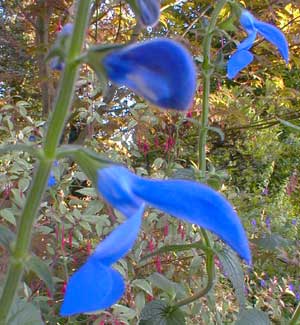
'Guanajuato'
Gentian Sage
"It is only when you start a garden,
probably after age fifty,
that you realize something important happens every day."
-Geoffrey B. Charlesworth,
1994
1994
 Salvia patens as a species has been gardened since 1838. Its cultivar 'Guanajuato' was discovered in 1991 during a botanical expedition to Mexico by England's modern plant explorers James Compton, John d'Arcy & Martyn Rix.
Salvia patens as a species has been gardened since 1838. Its cultivar 'Guanajuato' was discovered in 1991 during a botanical expedition to Mexico by England's modern plant explorers James Compton, John d'Arcy & Martyn Rix.It is named for the quaint colonial city of Guanajuato, in the State of Guanajuato, in the Sierra de Guanajuato mountain range of Mexico, where this variety was first collected. The name means "Place of Frogs" in an indigenous language.
Spikes of a clear soft-blue or turquoise-blue parrot-beak or claw-shaped blooms are present for an extended period, July to November or longer here on Puget Sound, until the first hard frost elsewhere. If during the growing seasons there is an interruption in flowering, as there is apt to be, cutting it back by a third or half should get it going again. Deadheading spent flowers also keeps it going.
'Guanajuato' can be a larger taller clump than for the species, with larger flowers (to two inches). It to some extent resembles a larger showier version of S. guaranitica 'Black & Blue' Anise Sage. To maximize flowrfulness, it may want monthly liquid fertilizing during the summer, which however I don't necessarily provide & get sufficient flowers even so.
It is ideal to keep the clump no taller than eighteen or twenty inches or it will get floppy & its large leaves will crowd & overshadow nearby perennials. But if never pruned 'Guanajuato' can grow to four feet & require staking to restrict it from sprawling & tipping. It gets leggiest if too shaded.
 When temperatures drop toward winter, the foliage dies to the ground, & can be quite late to re-emerge the following spring, so spring-flowering bulbs can be planted in the same vicinity to dominate the location at start of the growing seasons, & the bulbs will be done flowering & about ready to have their fading foliage clipped back when the Gentian Sage is getting going.
When temperatures drop toward winter, the foliage dies to the ground, & can be quite late to re-emerge the following spring, so spring-flowering bulbs can be planted in the same vicinity to dominate the location at start of the growing seasons, & the bulbs will be done flowering & about ready to have their fading foliage clipped back when the Gentian Sage is getting going.S. patens is not terribly cold-hardy & it is the recommendation of Thompson & Morgan to lift the tubers & store them in winter as one would dahlias. I would rather have it as an annual than go to so much effort, & I'm not sure I would really liken a young root as a "tuber" until its a few years old; it will be tenderest in the garden before rather than after a good solid tuber develops. It oughtn't require such special treatment here in Zone 8, & certainly not in Zone 9, though ours did vanish after three years, due I'd guess to an especially wet winter rather than a cold one.
It is trouble-free & low-management when grown as an annual in much colder zones (to zone 4), but here in Zone 8 there should be every chance of it perennializing so long as it isn't too wet during winter dormancy. Positioning on a sunny wall under eaves might provide the winter-dryness it needs, or on a garden ledge or raised area that drains rapidly after rainfall, or mulched with large leaves that help barrier the soil from rainfall. Extremely sharp-draining soil should improve the odds of it perennializing. During the summer it does not like outright droughtiness but should be moderately irrigated.
If it does "take" the clump will get larger each year, spreading rhizomitously, & will eventually require division late winter or in early spring before re-emergence. On Puget Sound it wants full sun but also does well in bright shade though needing to be staked, & when grown inland or further south (to Zone 9), it may prefer bright shade lest its leaves are sunburnt.
See also:
Salvia patens 'Blue Angel'